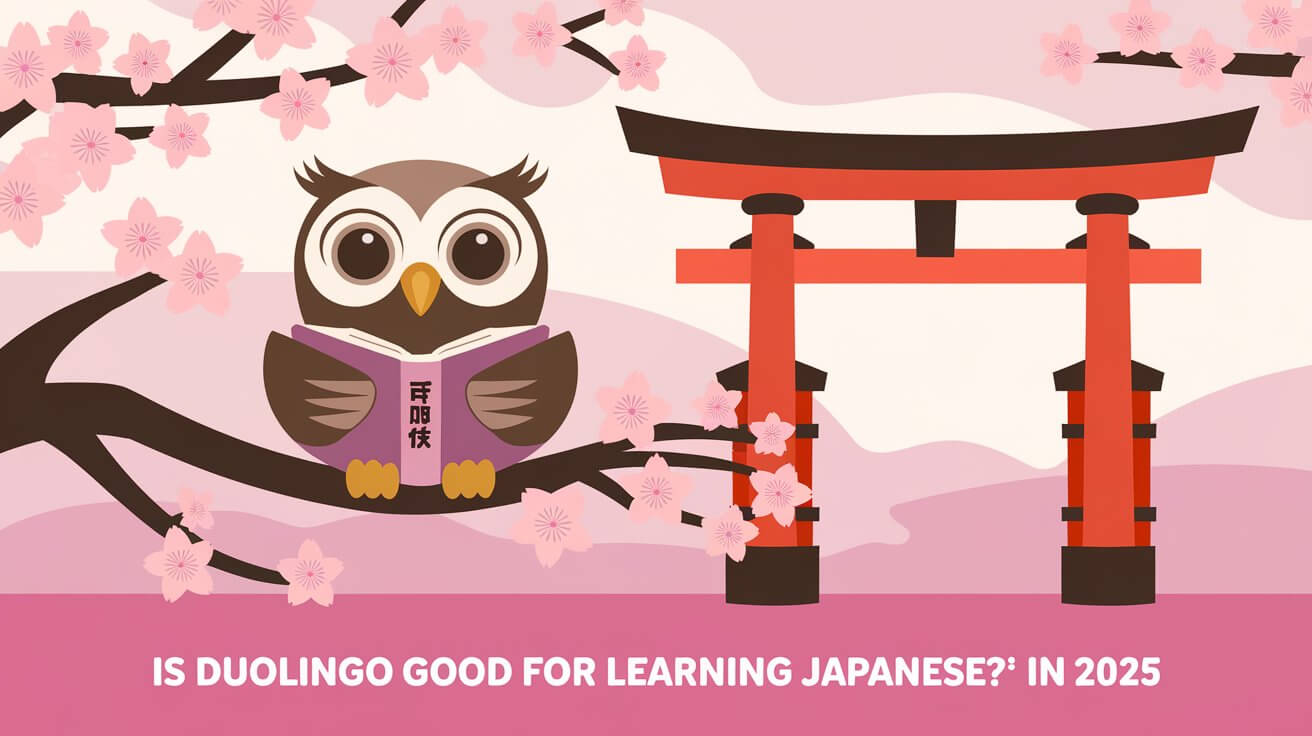Duolingo has been downloaded over 500 million times worldwide. It’s a favorite among language learners, including those aiming to learn Japanese. The app offers a “learning tree” and practice for Hiragana and Katakana. This Duolingo review will dive into its features and how well it teaches Japanese.
For those wanting to learn Japanese, Duolingo is a helpful tool. It has exercises like picking the missing word and translating sentences. With 103.6 million monthly active users, Duolingo is a top choice for language learners. Yet, it’s important to weigh its pros and cons for learning Japanese.
Japanese Language Features on Duolingo
Duolingo is a top app for learning languages. It has a detailed Japanese course with many features. The course has 133 topics, each with mini-classes. This covers a lot of Japanese language features.
Lessons on Duolingo are short, lasting from 5 to 15 minutes. This makes it easy to fit them into your day. The app teaches Japanese through writing systems, vocabulary, and grammar.
Writing System Coverage
Duolingo’s Japanese course covers Hiragana, Katakana, and Kanji. It teaches Hiragana and Katakana first, then adds Kanji later. This way, learners get used to Japanese writing without feeling overwhelmed.
Vocabulary Building Tools
Duolingo has tools to help build vocabulary. It uses interactive lessons and exercises. From the start, learners learn new words with their Kanji, then move to sentences.
Grammar Lesson Structure
Duolingo’s lessons show how to form syllables with consonants and vowels. The structure helps learners understand and use grammar rules in real situations.
Duolingo’s Japanese course is a great tool for learning Japanese. It has interactive lessons, vocabulary tools, and a clear grammar structure. It’s perfect for anyone wanting to learn Japanese.
| Feature | Description |
|---|---|
| Writing System Coverage | Covers Hiragana, Katakana, and Kanji |
| Vocabulary Building Tools | Interactive lessons and exercises |
| Grammar Lesson Structure | Designed to demonstrate syllable formation and grammar rules |
Core Learning Methods and Course Structure
Duolingo’s Japanese course is made to be easy and fun. It focuses on building vocabulary and teaching grammar. You can start at the beginner or advanced level, depending on what you already know.
The course covers many topics, from simple greetings to complex subjects like ecology and history. Duolingo uses spaced repetition to help you remember words. It breaks lessons into smaller parts to make learning easier.
Some key features of Duolingo’s Japanese course include: * Vocabulary building exercises to help learners expand their vocabulary * Grammar lesson structures to improve understanding of Japanese grammar * Immediate feedback on answers to enhance the learning experience * A habit-forming mechanism to encourage daily practice and maintain a streak
Duolingo’s Japanese course offers a well-rounded learning experience. It focuses on building vocabulary and teaching grammar. While it has some limitations, it’s a great tool for those wanting to improve their Japanese skills.
| Feature | Description |
|---|---|
| Vocabulary Building | Exercises to help learners expand their vocabulary |
| Grammar Lesson | Structures to improve understanding of Japanese grammar |
| Spaced Repetition | A model to help learners review previously learned words |
Japanese Script Integration
Duolingo makes learning Japanese scripts easy. It helps with Hiragana and Katakana, which are key for reading and writing. This is vital for getting pronunciation right.
Knowing Japanese scripts well is key for good communication. Duolingo teaches Hiragana, Katakana, and Kanji well. This helps learners build a strong base in Japanese.
- Hiragana introduction: Duolingo starts with the basics of Hiragana, teaching learners the fundamentals of the script.
- Katakana practice system: The app provides a practice system for Katakana, allowing learners to improve their reading and writing skills.
- Kanji learning approach: Duolingo’s approach to Kanji learning is designed to be engaging and effective, with lessons that build on previous knowledge.
Duolingo makes learning Japanese scripts fun and effective. This helps learners get better at pronunciation and understand Japanese culture better.
| Script | Description | Importance |
|---|---|---|
| Hiragana | Introduction to the basics of Hiragana | Essential for reading and writing |
| Katakana | Practice system for improving reading and writing skills | Important for pronunciation training |
| Kanji | Comprehensive approach to Kanji learning | Critical for understanding cultural context |
Progress Tracking and Gamification Elements
Duolingo’s language learning platform has many features to track progress and motivate learners. It’s a great online Japanese course with over 6 million learners. The app uses gamification like daily streaks and XP points to keep learners engaged. But, it might make learners focus more on the app than actually learning the language.
The benefits of Duolingo’s progress tracking and gamification elements include:
- Enhanced motivation and engagement
- Personalized learning experience
- Opportunities to compete with other learners
Some key statistics about Duolingo’s Japanese course include:
| Feature | Description |
|---|---|
| Number of learners | Over 6 million |
| Types of exercises | Word arrangement, translations, matching pairs, speaking practice, and vocabulary tests |
| Kanji coverage | 1,350 kanji, corresponding to JLPT levels N5, N4, and some N3 |
Using these features, learners can create a good study plan. They can make the most of Duolingo’s online Japanese courses. This way, they can reach their language learning goals on this platform.
Is Duolingo Good for Learning Japanese? An In-Depth Analysis
Duolingo is a well-known tool for learning Japanese. It has a detailed course with many features. For effective Japanese learning, the right tools are key. Duolingo is great for beginners to start their Japanese journey.
Duolingo makes learning Japanese fun and interactive. It has short lessons for practicing vocabulary, speaking, listening, and reading. But, some users say it lacks chances for speaking practice and cultural context.
Still, Duolingo is a good choice for learning Japanese. Its method helps keep learning going over time. To get the best from Duolingo, aim to reach level 5 in all skills for better retention.
| Feature | Description |
|---|---|
| Pronunciation Training | Duolingo offers pronunciation training through interactive exercises |
| Cultural Context Integration | While limited, Duolingo provides some cultural context through its lessons and stories |
| Real-World Application | Duolingo’s lessons are designed to be applicable in real-world situations, making language learning more practical |
Duolingo is a helpful tool for learning Japanese, perfect for beginners. It has its limits, but its interactive lessons and detailed course make it a great starting point for Japanese learners.
Audio Components and Speech Recognition
In a Duolingo review, the app’s audio and speech recognition features really shine. These tools help users get better at speaking, which is key in learning a new language.
The speech recognition tool lets users practice speaking and get feedback on how they sound. While it’s useful, it’s not perfect. Sometimes, it might say you got something right even if you didn’t.
Some main points about Duolingo’s audio and speech recognition are: * Audio lessons that last 5-10 minutes * A tool that checks your pronunciation * Ways to practice speaking and listening * A system that tracks your progress and rewards you for daily practice
Overall, Duolingo’s audio and speech recognition are big pluses. They let users practice speaking and listening, which boosts their confidence in speaking. These features are a big part of why Duolingo is so good for learning languages.
| Feature | Description |
|---|---|
| Audio Lessons | Typically 5-10 minutes long, covering various language topics |
| Speech Recognition | Provides feedback on pronunciation, with some limitations |
| Practice Opportunities | Regular chances to practice speaking and listening skills |
| Tracking System | Motivates daily practice and rewards streaks |
Limitations of the Platform
Duolingo is great for starting with Japanese, but it has its limits. It doesn’t give much cultural context. Also, it doesn’t offer enough chances to practice speaking.
This can make it hard for learners to talk like a native in real life.
Some of the main issues are:
- Duolingo doesn’t explain grammar well, making it tough to learn beyond basic words.
- It sometimes uses phrases that don’t sound natural, which can confuse learners, like with plurals and particles.
- It doesn’t cover kanji well, which is important for getting good at Japanese.
Even with these problems, Duolingo is still very popular. Millions of people use it to learn languages. But, to really get good at Japanese, you might need to use other tools too. Like grammar guides and apps to learn more words.
| Limitation | Description |
|---|---|
| Lack of cultural context | Insufficient exposure to cultural nuances and real-world applications |
| Limited speaking practice | Restricted opportunities for learners to engage in conversational practice |
| Inaccurate grammar rules | Errors in grammar explanations and phrases, affecting learner understanding |
Study Plans and Time Commitment
To learn Japanese on Duolingo, you need a study plan. It should include both grammar lessons and pronunciation training. Learning Japanese takes about 2,200 hours, so being consistent is key.
Each Duolingo lesson is just 5 minutes long. With 26,400 lessons needed for fluency, it’s a big commitment.
Try to study for 30 minutes, five to six days a week. This can be split into:
- 15-20 minutes for grammar and vocabulary
- 10-15 minutes for pronunciation practice
Sticking to this plan can help you reach an intermediate level in two to three years. But remember, Duolingo is just one tool. Use it with grammar books and kanji tools for a full education.
Duolingo Japanese course has over 100 units, each with many lessons. It’s important to stay motivated and track your progress. Duolingo’s design, with daily reminders and streaks, can keep you going towards your goals.
Supplementary Resources and Tools
To get the most out of a language learning platform like Duolingo, using extra resources is key. These can include more practice materials, community features, and tools from outside the platform. By using these, learners can dive deeper into the culture and boost their language skills.
For learning Japanese, there are many helpful tools. Websites for language exchange, podcasts, and online courses are great. They offer a full view of the language, including grammar, vocabulary, and culture. For example, combining a platform with a language exchange site can improve speaking and listening.
Additional Practice Materials
Apps and online worksheets are great for extra practice. They help learners get better at grammar, vocabulary, and reading. They’re perfect for those who want more practice or need a review.
Community Features
Features like forums and social media groups connect learners. They’re great for asking questions, sharing tips, and working together. This creates a supportive community and keeps learners motivated.
External Resource Integration
Linking to other language learning sites or apps is very useful. It gives learners access to more tools and resources. This is great for practicing specific skills like speaking or listening, making learning more complete.
| Resource | Description |
|---|---|
| Language Exchange Websites | Practice speaking and listening skills with native speakers |
| Podcasts | Improve listening skills and learn about cultural context |
| Online Courses | Learn about grammar, vocabulary, and cultural context in a structured environment |
Premium Features Analysis
Duolingo offers many features for online Japanese courses. These features can make learning more fun and effective. For those who want to improve their skills, Duolingo’s premium features are a great choice.
These features include ad-free learning, offline access, and special content. They help users stay focused and motivated. Premium users also get tools like progress tracking and personalized feedback.
Here are some benefits of Duolingo’s premium features:
- Ad-free learning for a more focused experience
- Offline access to learn anywhere, anytime
- Exclusive content to supplement online Japanese courses
- Progress tracking to monitor learning progress
- Personalized feedback to improve language skills
Duolingo’s premium features can greatly enhance your learning experience. They offer a more complete and effective way to learn Japanese. With these tools, you can improve your skills and reach your goals.
Final Thoughts
Duolingo is a great way to start learning Japanese. It’s not the only way to become fluent, but it’s a great help. The app makes learning fun with its games and is easy to use on many devices.
Duolingo teaches you the basics well, like writing and speaking. It starts with simple lessons and gets harder as you go. But, it’s not perfect. You might not get to practice speaking much, and you could hit a learning wall without more help.
To get the most out of Duolingo, add other learning tools to your routine. Try books, language exchange programs, and real-life experiences. This mix will help you learn Japanese better and more fully.
Duolingo is a great tool for learning Japanese. It’s fun and easy to use. With a little extra effort, you can make good progress and enjoy learning this beautiful language.
Common Questions
What are the Japanese language features offered on Duolingo?
Duolingo’s Japanese course teaches the writing system, like Hiragana, Katakana, and Kanji. It also helps build vocabulary and teaches grammar in a fun way.
How does Duolingo’s core learning methods and course structure work for learning Japanese?
Duolingo’s Japanese course focuses on learning words and grammar. It uses a fun, structured approach to keep learners engaged.
How does Duolingo integrate the Japanese scripts into the learning experience?
Duolingo introduces Hiragana and Katakana. It also teaches Kanji as part of the Japanese language curriculum.
What are the progress tracking and gamification elements on Duolingo, and how do they impact the learning experience?
Duolingo uses streaks, points, and tracking to keep learners motivated. These features make learning Japanese fun and engaging.
Is Duolingo effective for learning Japanese, and how does it perform in areas like pronunciation training, cultural context, and real-world application?
Duolingo is good at some things, like pronunciation and cultural context. But, it has areas for improvement in real-world application.
How do Duolingo’s audio components and speech recognition features contribute to the learning experience?
Duolingo’s audio and speech recognition help learners improve their Japanese speaking skills. They are key to mastering pronunciation.
What are the limitations of Duolingo as a platform for learning Japanese?
Duolingo lacks some language elements and has structural weaknesses. These can limit the learning experience.
What study plans and time commitments are required to effectively learn Japanese on Duolingo?
To learn Japanese well on Duolingo, you need a good study plan and time. Focus on grammar and pronunciation to get the most out of it.
What supplementary resources and tools are available to Duolingo users for enhancing the Japanese learning experience?
Duolingo offers extra materials, community features, and ways to integrate external resources. These can enhance your learning experience.
What are the premium features offered by Duolingo, and how do they impact the Japanese language learning experience?
Duolingo’s premium features offer more tools and resources for learning Japanese. But, consider the benefits and drawbacks before deciding.







